|
FAQs about Blue-Green Algae Identification
2
Related Articles: Blue-Green
"Algae"/(Cyanobacteria), Embracing
Biodiversity, Green Algae By Mark E. Evans, Green Algae, Green
Algae 2, Avoiding Algae
Problems in Marine System, Algae Control, Marine Maintenance,
Nutrient Control and Export,
Marine Scavengers, Snails, Hermit
Crabs, Mithrax/Emerald
Green Crabs, Sea Urchins, Blennies, Algae
Filters, Ctenochaetus/Bristle Mouth
Tangs, Zebrasoma/Sailfin Tangs,
Skimmers, Skimmer Selection, Marine Algae, Coralline Algae, Green Algae, Brown
Algae, Diatoms, Brown Algae,
Related FAQs: BGA Identification 1, BGA/Cyano ID 3, BGA/Cyano ID 4, & Controlling: BGA/Cyano,
Green Macro-Algae ID 1, Caulerpas, Green
Macro-Algae 1, Green Macro-Algae
2, Green Macro-Algae 3,
Green Macro-Algae 4, Chlorophyte Behavior, Chlorophyte Compatibility/Control,
Chlorophyte Selection, Chlorophyte Systems, Chlorophyte Nutrition, Chlorophyte Disease, Chlorophyte Reproduction/Propagation,
Marine Algae ID 1, Marine Algae ID 2, Marine Algae Control FAQs II, Marine Algaecide Use, Nutrient Limitation, Marine Algae Eaters, Culturing Macro-Algae; Red/Encrusting Algae, Green Algae, Brown/Diatom Algae,
|
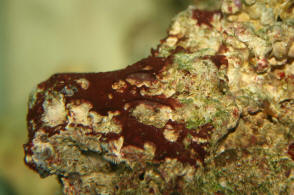 |
 |
New Print and
eBook on Amazon
Marine Aquarium Algae Control
by Robert (Bob) Fenner
|
|
Cyanobacteria? What does the Kool-Aid man say?
"Oh yeah!" 1/20/10
Dear WWM Crew, I am hoping you will help me figure out what type
of nuisance organism this is, so that I may eradicate it once and
for all.
<Definitely Cyano/BGA>
First, about the tank: a 6 gal JBJ Nano up for 3 + months with
varied Cnidarian frags (as you can see) and one fish. Lighting:
36 W of 50/50 PC, on for 11 hrs/day. Small, struggling refugium
in one of the back chambers
with Chaeto only (just upgraded the lighting to that chamber
today, so hopefully the Chaeto will thrive). Use ChemiPure Elite
and Purigen, covered by fiber floss, in the first chamber. Flow
is provided by 160gph return and
an additional 70gph small powerhead blowing across the back of
the tank. Do regular 10% water changes twice weekly. Feed daily,
but I do try to be judicious with the feedings by only target
feeding the corals 2-3x wk and
giving the fish a few flakes the other 2 days (5 day work week).
Water parameters are exemplary.
So this looks like Cyano to me. However, it only exists on the
sandbed - why is that?
<Best circumstances for this species likely>
I've tried adjusting the flow so that it almost blows the
sand in the front of the tank onto the rocks. The reddish
algae-like substance does not grow elsewhere. There is
filamentous brown algae on the back wall of the tank, and a small
(1x1 inch) patch of green hair algae on one rock (stable), but
otherwise only coralline on the rocks and a little on the glass.
I get it that there is excess nutrient in my system (waste), else
there would be no GHA or the brown algae on the back of the tank.
But that stuff doesn't bother me like this red covering on my
sand bed. It keeps coming back no matter what I do. It sticks to
the sand. It can be picked up in sheets with a forceps. Could it
be something other than Cyano? Other than reducing my feeding,
cutting back on my lighting time, is there
anything else I should be doing?
<Mmm, there are a few other approaches...>
I am afraid that if I increase my water changes to more than 10%
two times a week the corals will become stressed due to unstable
water parameters. Am I wrong about that?
<Not wrong... an issue with small volume systems
period>
Because I could certainly change 25% of the volume twice a week.
What do you think?
<That you should read here:
http://www.wetwebmedia.com/bluegralgae.htm
and the linked files above... till you understand the gist of
your options... Perhaps a tied-in sump/refugium? A DSB there?
Some chance of culturing other photosynthates? Bob Fenner>
|
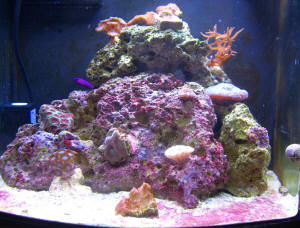 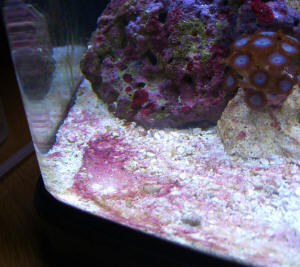
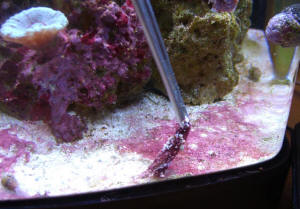 |
|
Turf, alg. ID, control 10/8/09
Hi, I am fairly adept at reef keeping and know what causes algae
and the various remedies for that problem, however, my 55 gal.
has developed what I believe is Turf algae. I don't over feed
and have a phosphate reactor. This just recently seemed to appear
coinciding with adding Oyster feast for my LPS. Here is a pic of
what I have and any suggestions on eradicating it are
appreciated.
http://i269.photobucket.com/albums/jj46/unclejed_bucket/55galbright024.jpg
<Ummm, need more information to give a more specific
response... but, this looks like it could be a
Cyanobacteria/BGA... rather than a "green"
(Chlorophyte) "turf algae"... Read through here:
http://wetwebmedia.com/avoidingalgaeproblesm.htm
and the linked files embedded and above... for ideas on what you
might do, the sorts of data we're looking for. Bob
Fenner>
|
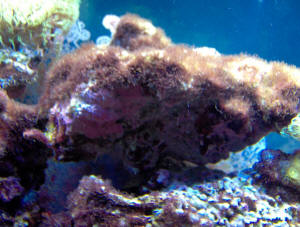 |
|
re: Turf ... read please
10/9/09
Hi Bob, your response puzzled me. The pic is real clear showing
short, bristle like hair that can not be scrubbed off, I have
tried. With all due respect, I know what Cyano bacteria is and
this is not.
<Mmm... I assure you, I "took" three college courses
in Phycology (gen., culture and seminar)... and have done a bunch
of algae articles, presentations... NOT to mention who knows how
many hours fighting
Thallophytes and the Monerans that are BGA over the years...
There ARE blue-greens that indeed look just like this... The only
way to discern the various Divisions (eq. to animal Phyla) is via
microscopic examination... and to lesser extents, storage food
and other analyses...>
You say you need more info but didn't say what info. If you
tell me what you want to know I will send it
along......Thanks
<... Do please peruse where you were referred to. B>
|
Cyano/slime?, 9/24/09
Good morning ladies and gentlemen!
<Hello!>
Thank you for taking the time to provide such a wonderful site,
you've been absolutely invaluable to so many. Dare I say,
you've been my rock.
<Don't get between us and our hard place.>
Yea, I could go into so many cheesy puns, but... Well, anyway.
<Hee Hee>
Just had a quick question about slime algae, I'm not finding much
about it on the site, other than people confusing BGA for it.
<Very well could be, not all Cyano/BGA is actually blue-green, often
more red or purple.>
Some of the top rocks in my 30gal have started to produce some blotches
of very dark maroon 'algae' (?)
<Could still be Cyano, or Dinoflagellate/Diatoms.>
As I've been battling Cyano for a couple of months after a move I
notice quite a big difference in the color and behavior of the dark
stuff. My Cyano will wane at night and it's real easy to pick off
and clear out during water changes, the other stuff however doesn't
wane and is very stubborn about coming off the rock, it's not
'crusty' per se, so I don't think it's coraline, the
only other thing I could come up with is slime algae. I would be happy
to send a picture if you need it.
<Might help.>
If this is what I propose, is it bad? It's not overtaking the tank
or anything, and honestly I kinda like the way it looks. Where can I
find more info on this particular issue?
<Depends on what it is, "slime algae" usually refers to
Cyanobacteria, but could be something else.>
Thanks again so much!
<Welcome>
Jéan Dodes
<Chris>
|
Algae confirmation and pics
Blue/Green Algae 8/5/09
Howdy gang!
<Hello, Josh here.>
I actually did some research before sending this but am looking
for confirmation.
<Good.>
This stuff, which is what I assume to be BGA/Cyano, has recently
popped up.
I had been battling a massive GHA outbreak that I finally got
under control with a GFO/GAC reactor and RODI filter changes.
That was about 2 months ago.
Over the last 2-3 weeks this stuff showed up.
<I think you got your identification dead on. I imagine you
already read this page, but for reference:
http://www.wetwebmedia.com/bluegralgae.htm, I would recommend
continuing the same path you used to rid yourself of green hair
algae, but supplement that with removal and manual destruction of
the blue green algae colony.>
Thanks for looking and hopefully the pics will help.
Robb in Austin
<You're welcome,
Josh Solomon temporarily in SoCal.>
|
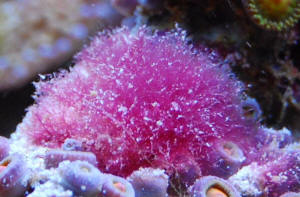 |
Algae ID: BGA\Cyano 4/20/2009
<Hi Penny>
Tank is 90 gallons (30g sump, no refugium)
Nitrate0, Nitrite0, Phosphate0,ph8 night time-8.25 daytime, Ammonia0,
Calcium 420ish
I have two bags of Chemi pure elite along with two Phosban reactors,
(one has Phosban, one carbon)
Bubbleking 180 skimmer, 2xVortech MP40's for movement set on reef
crest (stronger flow)
<OK>
My tank is about 3 months along now, 100+lbs LR, and I have noticed a
slimy dark film on my sand (not super dark), some might not see it but
I do. (like diatoms but slimier) It's darker at night and
lightens
during the day but is a visible slime none the less. And in the evening
bubbles form on it, more bubbles at night then during the day. It is a
definite brown color though. I siphoned it all out and cleaned the
substrate and put it back in but I see it forming again now.
<Blue-Green Algae>
At first I wondered if it was the Coral FrenzY I was using (not lots,
maybe four times total in the last month but twice in the last week), I
only have soft corals and was told that they don't need a product
like coral frenzy so I have stopped using it. I have started feeding
very very lightly, poor fishies. But it still seems to be
coming back. I am buffering my Alk to about 10 from 7 (Seachem's
Reef Buffer), which also raises pH up which I hear is good for algae, I
dose at night when pH is low.
But to be truthful I have no clue as to what kind of algae or bloom is
happening. I don't want to just treat with something, guessing. I
am doing all I can, I do 16gallon water changes once a week. I can up
them if need be. The algae (or whatever it is) doesn't seem to be
"wild" or out of control. It spreads mostly in the front of
the aquarium in the open. I can see it mostly (darkest) around the open
brain and plate coral, like a brown border. It isn't on any of the
LR. Is this part of a growing phase of my tank?
<Not uncommon, but not desirable either.>
Or am I doomed? My levels seem good to me but I want to nip this in the
bud, is it one of those things that once it starts it's hard to
stop?
<It will take some work, but not insurmountable.>
Or is there hope? Please say there is hope.
<There is hope.>
I am very sorry for the long winded email but I wanted to explain it as
thoroughly as possible. Listing tank readings etc. I am not sure what
to do, I want to catch it early if it's something bad. I hope this
explanation helps. I searched through your website (holy crap!) and
couldn't find something similar, all I read was bubbles on the
sandbed are bad. So I am hoping for the best.
<What you have is Blue-Green Algae (Even if it is not blue-green in
color)
Not at all uncommon in new systems. It is a 'pest' algae that
you will want to keep under control. You can read more about it and how
to control it here:
http://www.wetwebmedia.com/bluegralgae.htm
http://www.wetwebmedia.com/bgafaqs.htm >
Thanks very much
<My pleasure.>
Penny
<Mike>
Re: Algae ID: BGA\Cyano 4/20/2009
Ok (crap).
<Hehehe Fighting a minor outbreak myself, I understand the sentiment
>
I have a good skimmer, good flow, carbon etc.
<Which is good, as I said, it is not at all uncommon in
"new" systems>
So basically light feedings and siphon up the infected sandbed and wash
it in FW and replace?
<I would just try to siphon the algae up, but this would work as
well.>
Should I increase my water changes from once a week to 2 or 3
times?
<10 - 15% once a week is standard. You can do smaller, more frequent
changes for the time being.>
I have a UV, I hope that might help. I always turkey baster the LR
before siphoning for the WC.
<Very good.>
How often do tangs need food? I have a yellow tang, Foxface and hippo
tang. I want to feed less but have read tangs need constant
grazing.
Two light feedings a day?
<They are constant grazers, two light feedings per day plus some
green or red algae for them to munch on For my tang, I add a strip of
sushi Nori I the morning, and remove it in the afternoon.>
Sorry to be a pain.
<Not at all.>
Thanks.
<My pleasure>
Penny
<Mike>
|
Black Filamentous "What" 01/31/09
Greetings from a relative newcomer to the field. I have been
watching this "thing" on what I believe to be a
Platygyra. It is black, and getting "longer" all the
time. Very filamentous and feathery in nature. There are now what
appear to be "air bubbles" appearing within the
structure itself....two or three closest to the coral itself, and
two individual "bubbles" equally spaced between there
and where the structure becomes mostly filament. At present it is
approximately 4 to 4.5 inches long and appears to be
"growing". <It's a kind of Cyanobacteria. In my
experience, the type that grows like this (dark and stringy) is a
real pain in the fins! I'd immediately check your parameters,
do a water change, etc.> The operative questions are: any idea
what it is and if so, is it desirable, undesirable, or just
"there". <In my experience, in small amounts
it's ok. But it can quickly grow to be a total nightmare.>
Thanks in advance. Bob Wright
<Best,
Sara M.>
Thanks
|
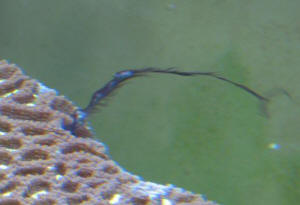 |
|
Slime Algae 1/18/09 Hello, I have spent hours
reading on your website it is great. <Awesome.> I have a
55gal garden reef , 10gal refugium, cpr wet/dry with built in
skimmer. The uv sterilizer and carbon only once or twice a month.
For lighting I run a 8 bulb 432watt t5 light for 8 hours a day 2
hours of actinic before and after the 8 hour period. My water
parameters seem to be right ph 8.3 calcium 400, magnesium 1300,
nitrites, nitrates, ammonia and phosphate all at 0. I have been
having a problem with some type of slime covering everything, I
have scrubbed it off several times. I have three 400gph Hydor
Koralia for water movement with 500gph return pump. My sand bed
is only about 2-3 inches deep and gets stirred up by my clownfish
a lot I was thinking maybe this was causing the problem but I
wanted to ask the pros. <Crud on the sandbed is indicative of
other issues, but for what it is worth this really should be
increased to 4-5' for a true DSB or reduced to 1' or less
for cleaning. The middle ground tends to accumulate detritus and
nutrients without any benefit.> I have 5 SPS's, frog
spawn, elephant ear mushroom, brain coral, crocea clam and
several trumpet corals. My refugia has Caulerpa and Halimeda
plant in it. I have a sebae clownfish, tomini tang and a damsel.
I do 5 gal water changes every week. Sometimes when the sand gets
stirred up I can see black spots in it when you stir the black
spot up its like dust. I have included a photo of the slime.
<BGA.> I appreciate you taking the time to read this and
any suggestions on what to do to get rid of this or maybe just
what it is would be great. <The fueling factors are introduced
somewhere, either feeding or source water. Your levels test OK
because they are being consumed as produced. Do see
http://www.wetwebmedia.com/bluegralgae.htm and the linked files
above. All the solutions to your issue are held there within.>
Thanks for the help and such a great website Dan
|
[1]%20slime%20alg.JPG) |
|
Identification - Red Algae of sorts... reading
12/14/08
I'll try to identify the best I can without pictures.
<In this day and age... better to send images along>
I have what appears to be a red algae, not like the Cyanobacteria
that I have been reading about. This specimen has not been
spreading to my gravel at all, but rather on top of many of my
rocks and growing almost like it is in shelves.
<Oh?>
It has been spreading rather quickly. I have removed it once from
all of the rocks, and when it comes off it comes in chunks and
then leaves a lighter color underneath. I removed most of it and
changed water, and cleaned filters, but it has come right back.
I'm having a difficult time getting control over it as I
don't know exactly what I'm dealing with. Any help you
can give is most appreciated. Please keep up the good work!
Thank you,
Sean
<Please peruse here: http://wetwebmedia.com/marinvind1.htm
the files linked at top... Algae Identification... and the links
you lead yourself to in turn. Enjoy the learning, tool. Bob
Fenner>
Re: Identification - Red Algae of sorts
12/14/08 Thank you for the reference. I actually went
through that page prior to emailing you and couldn't find an
image that resembled what I thought I had. I'm attaching some
photos this round so hopefully you'll be able to help me
correctly identify what I have so that I can treat it
accordingly. Thank you for the resources that you have created!
<Ahh, and thank you for sending along the attached pix. This
is assuredly Cyanobacteria... Blue Green "Algae"...
there are a few approaches to its control... Please read starting
here: http://wetwebmedia.com/bluegralgae.htm and as much of the
linked FAQs files above as you require to familiarize yourself
with your options... Cheers, Bob Fenner>
|
 |
 |
New Print and
eBook on Amazon
Marine Aquarium Algae Control
by Robert (Bob) Fenner
|
|
|

